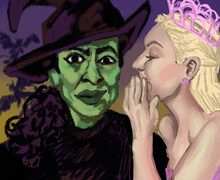UN Human Rights fellow discusses how museums can help address racial inequity
Screenshot from Zoom
Andrew Saluti (top) moderated a discussion with keynote speaker Stephanie Johnson-Cunningham on culturally responsive museums and the impact of deaccessioning — the removal and sale of pieces of art to raise funds.
Get the latest Syracuse news delivered right to your inbox.
Subscribe to our newsletter here.
Before Stephanie Johnson-Cunningham could jump into a Q&A about art and museums, the United Nations Human Rights fellow had more to share.
Even though her organization Museum Hue — which aids creatives of color — has worked with different museum professionals, art academia wasn’t always on her radar. But after guest lecturing at different universities and hearing from students about their own interests, Johnson-Cunningham found it to be a critical part of her field.
Johnson-Cunningham and moderator Andrew Saluti, the museum studies graduate program coordinator at Syracuse University’s College of Visual and Performing Arts, spoke about Museum Hue, culturally responsive museums and the impact of deaccessioning on Wednesday night over Zoom. Her keynote was a part of VPA’s two-day symposium “Deaccessioning After 2020.”
For Johnson-Cunningham, deaccessioning, or removing and selling pieces of art to raise funds, isn’t just about using the money to buy other works. It’s also a way for institutions to use the funds for operational support, such as a museum paying their staff during the pandemic.
Johnson-Cunningham said art mainly leaves museums’ collections in two ways, either through sale or through certain pieces of art finding their way back to their countries of origin.
Despite museums disposing of or deaccessing work to make room for pieces created by artists of color, Johnson-Cunningham said they’re still not addressing the underlying issue of racial inequity within the arts.
“To be honest, there are a lot of people struggling to bring the issue of race to the forefront of museums,” she said.
A key part of the lecture was also spent on museum relevance and impact. As a museum professional, Johnson-Cunningham sees museums as meeting places to foster dialogue and spark ideas. “Museums are very much relevant,” she said.
However, Johnson-Cunningham pointed to an online survey that asked about 1,000 Americans their thoughts on museums. Despite the majority of participants deeming the institutions necessary, they weren’t sure if museums were relevant to someone’s experiences in politics and social justice.
Johnson-Cunningham and her organization partnered with the Museum Association of New York to promote museums that are addressing the necessity of work that relates to housing, mental health and food insecurities. She referenced the Frye Art Museum in Seattle, which hosted an exhibition called “Group Therapy” that touched upon topics of mental health like psychotherapy and wellness, she said.
“Back to the word ‘relevancy,’ we really have to think critically about how these institutions affect our lives,” Johnson-Cunningham said. “How are we holding these institutions up?”
Helping museums gain relevancy isn’t the only thing her organization has done. Besides being a hub for knowledge and networking, Museum Hue’s primary focus is to bring the topic of race to the forefront of the field. Johnson-Cunningham co-founded the organization back in 2015 to be more reflective of society and challenge the mainstream museum.
A way the organization has been doing this is through helping culturally specific museums. Johnson-Cunningham said these institutions are the leaders of community-centered approaches rather than collection-centered ones.
Johnson-Cunningham said culturally specific museums also not only provide a platform to showcase visual art, but also strengthen cultural ties. Two examples she gave were the Smithsonian’s Asian Pacific American Center and Native American museums such as the California Indian Museum and Cultural Center.
“Culturally specific museums provide the best lessons in equity,” Johnson-Cunningham said. “They were created to counter historical omissions, combat misconceptions and problematic depictions highlighting artistic practices and cultural contributions often absent from mainstream museum narratives.”
In 2020, Johnson-Cunningham created an online database featuring over 100 culturally responsive museums across the country. She said the list is still growing.
Published on March 17, 2021 at 11:42 pm
Contact Christopher: cscargla@syr.edu | @chrisscargs






